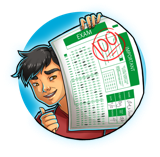Exploring potential healthcare careers? Dive into what it takes to study physical therapy and see if it’s the right career path for you!
Physical therapists, also known as physiotherapists, work to improve mobility, prevent or treat injuries, and reduce pain for patients. They design and curate plans involving exercise and hands-on therapy to provide treatment all while educating patients on prevention and actions they can take at home.
From working with athletes to people of all ages and conditions, physical therapists are hands-on and always on their feet. Learn more about how to become a physical therapist from education and training to licensure and certification.
7 Steps to Become a Physical Therapist
1. Obtain a bachelor’s degree

The first step to studying physical therapy is to get your first degree! There isn’t a specific major requirement, but if you are able, pursue a degree in biology, kinesiology, anatomy, chemistry, or a related health field. This will provide you with the knowledge foundation for your next step to being a physical therapist–another degree.
2. Apply to a Doctor of Physical Therapy (DPT) program
It’s time to get another degree under your belt. Aspiring physical therapists must enroll in and complete a DPT program accredited through the Commission of Accreditation in Physical Therapy Education.
DPT programs are three years long and include classroom education and clinical rotations. To apply for a DPT program, you must use the Physical Therapist Centralized Application Service (PTCAS).
3. Complete (and excel in) your DPT program
In your DPT program, you’ll indulge in subjects like anatomy, physiology, biology, disease, pharmacology, and more. While some may advise you to work hard and study harder, you’ll need to learn how to study physical therapy concepts effeciently. Find what works for you, and maximize your study time with helpful resources like Picmonic, a mnemonic audiovisual learning tool made by physical therapy students for physical therapy students!
With the right approach, your tireless efforts will get you to your white coat ceremony at the end of your second year of school and through your final year of clinic rotations.
4. Pass the National Physical Therapy Examination (NPTE)

Two degrees! What’s next? That’s right—to become a physical therapist you must successfully pass the NPTE from the Federation of State Boards of Physical Therapy.
This exam assesses your knowledge and ability to apply physical therapy principles. Offered four times a year, you can retake this exam up to three times in one year if necessary. However, you should prepare diligently to pass the exam the first time!
Subscribe to Picmonic to gain access to all 430+ physical therapy mnemonics and 4,000+ fact quizzes to help you study physical therapy and practice active recall for the exam. Plus, take advantage of access to mobile apps, infographics, spaced repetition, and more to maximize your memory.
5. Obtain your state licensure to practice
Once you pass the NPTE, you’ll need a state license to practice. Licensing requirements vary by state, so double-check your state board to find out what criteria you need to fulfill. Oftentimes, states may require a background screening, additional training, and ongoing education.
6. Complete a residency program
Got your state license? You can now practice! But, wait, there are more steps to becoming a physical therapist if you want to embark on a special path. While not mandatory to practice, completing a residency program can provide additional training, coursework, and experience to enhance your skills and expertise. Furthermore, you can gain hands-on experience in one of the ten recognized specialized areas of physical therapy.
The ten specialties are:
- Neurology
- Oncology
- Cardiovascular and pulmonary
- Clinical electrophysiology
- Geriatrics
- Orthopedics
- Pediatrics
- Sports
- Women’s health
- Wound management
7. Become board-certified

If you’ve made it this far, what’s one more step? Achieve your board certification to showcase your expertise. The American Board of Physical Therapy Specialties (ABPTS) offers certifications in the ten specialties above. Board certification allows you to distinguish yourself as a leader amongst fellow physical therapists, your patients, and the community. Pat yourself on the back, prestige PT!
How long does it take to become a physical therapist?
The timeline and steps to become a physical therapist can vary depending on your goals and lifestyle, but it ranges from six to seven years of education and training and an optional year of residency. To break it down, you need three to four years to complete your bachelor’s degree and an additional three for your DPT. Fulfilling licensing requirements can take time too, so don’t forget to factor that in.
Which qualities should a physical therapist have?
To excel as a physical therapist, you need to have and hone certain qualities. These should include strong communication skills, empathy, patience, problem-solving, and more. Read more about what qualities to possess and why they’re important in this list of necessary physical therapy skills.
Physical therapist salary and job outlook
Wonder if all the steps to becoming a physical therapist will pay off in the literal sense? No judgment here! Physical therapy is a large job field with a positive outlook. According to the Bureau of Labor Statistics, the median annual pay for physical therapists in 2022 was $97,720.
Job opportunities are expected to increase in the coming years. And, most physical therapists hold positions at sports training facilities, rehabilitation facilities, hospitals, outpatient clinics, schools, and more.
Plus, physical therapy jobs are growing at a faster rate than other occupations with a projection to grow 15% from 2022-2032.
No matter what step you decide to take next, Picmonic is here for all your study needs! Embark on your journey, and sign up for Picmonic for physical therapy students.













